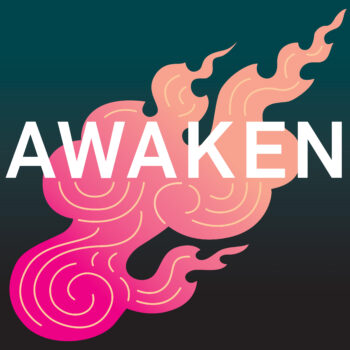
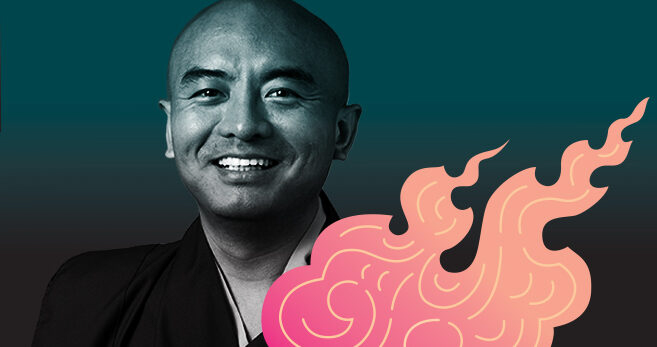
What is enlightenment? What does it mean to be truly awake? Are you awake?
Enlightenment can take many forms. In this final episode, we will look back at highlights from all our guests and consider enlightenment from Tibetan Buddhist perspective with Yongey Mingyur Rinpoche, a highly respected Tibetan Buddhist meditation teacher from the Kagyu tradition, one of the four main lineages of Tibetan Buddhism.
YONGEY MINGYUR RINPOCHE:
Everybody, no matter who they are, everybody has this wonderful nature. Everybody has this enlightened nature.
LAURIE ANDERSON:
What is enlightenment? What does it mean to be truly awake? Are you awake?
PATRICIA JAMES:
I found my heart.
ALOK VAID-MENON:
I have found this beauty within myself and the universe, let me share it with you.
TARA BRACH:
This heart wants to wake up. This heart wants to be loving.
BJ MILLER:
It feels like a dance and that there is no separation.
LATHAM THOMAS:
I felt this total oneness and connection to everything.
YONGEY MINGYUR RINPOCHE:
Everybody has the potential to become enlightened. This lifetime. Depending on the effort. (laughter)
LAURIE ANDERSON:
Welcome to AWAKEN, a podcast presented by the Rubin Museum of Art in New York City. I am your host, Laurie Anderson. In this ten-part series, we explore the dynamic path to enlightenment and what it means to wake up. We’ll hear from authors, artists, wisdom bearers, and Buddhist teachers, people who have experienced a shift in their perspectives on life throughout their personal journey. This podcast is inspired by the exhibition Awaken: A Tibetan Buddhist Journey Toward Enlightenment, which illustrates the stages of enlightenment through paintings, sculptures, and other objects. We use these artworks as a jumping off point to better understand the paths our guests have been on and where they are going.
While enlightenment can take many forms, in this final episode, we hear from all our guests, and we reflect on enlightenment from the Tibetan Buddhist perspective and how it may present itself in our everyday lives. Joining us is Yongey Mingyur Rinpoche, a highly respected Tibetan Buddhist meditation teacher from the Kagyu tradition, one of the four main lineages of Tibetan Buddhism.
YONGEY MINGYUR RINPOCHE:
My name is Yongey Mingyur Rinpoche, and I am a meditation teacher. I learned meditation since childhood and now I’m teaching meditation for others. I am the follower of Tibetan Buddhists, and within the Tibetan Buddhists, we have four lineage. So my main lineage is Kagyu-pa, but at the same time, I practice all the other lineage as well.
The main meaning of enlightenment is to fully recognize our true nature. So what Buddha said, We all have wonderful nature. So we can say basic innate goodness or Buddha nature or the original purity or the tathÄgatagarbha. There are so many wonderful names. But all this enlightened qualities are there with us right now, right here. But the problem is, so we have this enlightened nature, but we don’t feel like we are enlightened. Now we have a lot of problems–what we call the monkey mind problem. And there’s a lot of fear, panic, depressed, hatred, mind up and down. So many things. Why? Because of what we call ignorance.
And from the ignorance there’s aversion and craving. And these two make what we call samsara. Samsara meaning the circle of suffering. So there is an example, the seed of samsara, seed of suffering, seed of illusion, delusion, and misery. When the seed separate from the cause and the condition, no matter how the seed dry, when the seed is mixed together with the causes and conditions it will come back. But when seed burn and it become ash, and even as it disappear, then never come back again. So that is the state of enlightenment. Never come back to return to samsara after that.
APARNA NANCHERLA:
Life is suffering. Suffering is like an inherent quality of life. And I like that Buddhism just kind of names that very frankly, and doesn’t kind of try to gloss over it, because I do think there’s this tendency in American culture to put on a happy face or just, you know, always find the silver lining in everything, which is, you know, definitely something that is a good skill to have and something that helps you keep things in perspective. But I think it’s also important to remember there is pain, and pain is very much a part of life. And learning to handle yours and sit with it and acknowledge it feels more useful than just trying to avoid it or repress it or, yeah, just find ways to pretend it’s not there.
AMANDA PALMER:
I grew up in a family and in a culture that really glossed over the darker aspects of existence. And I think that left me with a hunger to understand and be connected to the dark because I knew it was there. It was really obvious it was there. Things were dying. People were dying, suffering was happening, pain was happening, but no one was fucking talking about it.
TARA BRACH:
What I’ve realized over and over again is, you know, we’re so afraid of our human imperfection of the conditioning that we each have that gets us insecure, and it takes the shape of obsessiveness or neediness or aggression. We get addictive. We all have this. And we think something’s wrong with us. And it’s so clear that the only way to awaken and be free is to love ourselves into healing. That we need to encounter what we feel is imperfect. We need to encounter the painful emotions and really bring a mindful, loving presence to it.
LAMA ROD OWENS:
Being awake is actually about being in relationship to the rough edges and the messiness. It’s messy. And when you get awake, it’s confusing because aren’t things supposed to be clearer? No, actually you’re seeing the complexity of everything. And then you’re given the space to respond to complexity.
LATHAM THOMAS:
Darkness is divine. Darkness is the beginning. It’s also the everlasting, but darkness is the place from which all things grow. When we think about a soil bed and what’s underneath, and before we even see a sprout, you know, before we even see like a really short stem or, you know, unfolding of a leaf, we’re seeing incredible root systems already in place before anything hits the surface for our eyes to see. Everything is underground working, right? When we look at the soil, there are earthworms and microorganisms that are working to keep things alive at the soil level. We know there’s a growth, right? We can’t see it””it’s happening in the dark, right? And a baby is born emerging into the light.
And if we can see that as also holy, it’s really important as well. And so I would invite that new framing around darkness for folks to lean into more deeply in even the times we’re living through. And so I see the moment that we’ve been living through, as painful as it has been for so many of us, as one of awakening, as one of setting us on a path towards liberation. Which, you have to move through these moments of waking up, like you have to rise up.
BJ MILLER:
We are living through a massive existential crisis. You know, that’s one way of putting this, and I’m a big fan of existential crises. They teach us so much, they have a way of showing us this self, the constructed self versus this sort of underneath it all self. I think a lot of us have kind of seduced ourselves into thinking we need that””whatever we need””that car, we need that thing, we need whatever we need, that outfit, we need that job, we need that role. We blah, blah, blah. It turns out we don’t really need those things. We want them. But here’s a moment where we can find some real clarity around the made up stuff from the bigger stuff. Here’s a moment where we might realize what’s really actually, when push comes to shove, really, really important to us and what we’re just as happy to let go of, where we realize how much we freaking need each other and how amazing it is to touch another human being. This idea of independence, this illusion of independence. There’s an illusion for you. Maybe we’re a little bit more prone to realize our interdependence.
So, an existential crisis is a terrible thing to waste. It’s a wonderful, painful experience, but it gets you to bigger truths. It has a potential to get you to bigger truths, has potential to break you down into that little nub. And then, then, then with the sort of wide clear eyes, if you have enough support and time, well, then you get to kind of reconstruct.
YONGEY MINGYUR RINPOCHE:
What people can do to feel more awakened? I think really important is we try to connect with awareness, loving compassion, and wisdom. These are the enlightened qualities that are with us all the time. And normally, what we call, we all have awareness, loving compassion, wisdom””24 hours. But of course at the beginning, we feel like, what? Even when I’m feeling hatred, do I have love and compassion? Are you kidding me, you know? So I thought same thing when I was young. But there is practice, systematic practice, how to recognize this within us.
So each time when we do that and that wisdom, compassion, love, awareness, really help our life, our job, people around us, and others to the world, we can give better contribution to the world, to the society. So it’s not like awaken mean suddenly one day morning and you wake up, then you become very free, clarity. It’s not like that. It’s just, recognize it there, right now, with you, that you never thought of that is here before.
So there are three main techniques: awareness, loving compassion, and wisdom. So maybe I will discuss about the awareness. So if someone is trapped in the monkey mind (badda-badda, yadda-yadda), then there’s a problem in the life. How to free from that? So normally when we are having this monkey mind, we try to avoid it. Try to stop that, try to block that. Then monkey mind actually become bigger. Or some people listen. Yes, sir. And we have become slave of the monkey mind. It doesn’t matter. Monkey mind is okay.
Awareness is like sky. So actually monkey mind is like cloud in the sky. If we have storms, maybe tornado, hurricane, whatever. Even the storm is so strong, it cannot change the nature of sky. You cannot shoot sky. You cannot block sky. You cannot do anything. Sky is always free, present, pure, calm. So awareness is always present with us. It is free from badda-badda-badda, yadda-yadda, yadda. It is always there, pure, calm. But the problem is we need to recognize that and how to recognize this awareness.
What role the meditation play as a tool for the journey for the enlightenment? The first important is, we have to use one object, so we can use the breath. Knowing the breath. And it’s a lot of, sort of, we can use anything as object of meditation: form, sound, smell, taste, sensation. Then in the end, we can use the badda-badda also. Badda-badda, yadda-yadda, panic, depression. I use my panic as support for awareness. So it’s very nice.
So when we be with the panic, awareness is bigger than panic. Panic is just a little storm in the sky, comes and goes, comes and goes. The real happiness, real peace, is with awareness. So of course at the beginning, not easy to discover this awareness. Like, normally sky is wonderful for us, but we are not knowing the sky. The birds always fly in the sky, not knowing the sky. Fish always swim in the water, not knowing the river. Same thing. There is practice. Systematic practice. It’s like learning a new skill.
First when I learned meditation, I was young. I had my life that time miserable because I had panic attacks. And I learned meditation from my father, and my father kept telling me, “Oh, you have wonderful nature. You have this enlightened nature.” And I never believed it at the beginning. But then as I practice every time, a-ha, you know what we call a-ha moment. Why I didn’t recognize that before it’s just here. Why I can see that? Wow, this is wonderful. I want everybody to see every time when we practice. There’s a lot of a-ha moments.
TARA BRACH:
I actually started a yes meditation at that point, which I used the word, yes. But it’s the energy of yes. Which really says, this is the reality of this moment. Just allow it to be here. It doesn’t mean, I agree. It doesn’t mean, I’m always going to be this way. If I have a self-judgmental thought, yes doesn’t mean I agree with the content of the thought. It just means, okay. Yes. Judgment is going on. And so I started practicing more and more like that. It was like, okay, this is the wave in the ocean right now.
And the power of it was that who I was, was more resting in that ocean-ness. I became more of that, that tender ocean that had room for the waves. And so this was really the heart of what I’ve been teaching to others over time is to be with what’s here, to courageously feel it and to hold it with that tenderness. Sometimes we just, all the best we can do is just say, okay, yes, for the moment. But if we keep staying, that yes turns into love, a field of love. And we start trusting more and more that we’re that field of loving more than the story in our mind.
LAMA ROD OWENS:
What’s been really helpful for me is what we would call benefactor practices, which is within the tradition of loving-kindness practices or metta practice. But we need to feel supported and connected, right? We need to feel loved or cared for, you know, and that’s the basis of this tradition of practices. But the benefactor practice for me, it’s like just imagining all these beings who love me and coming and sitting with me and loving me. And I just sit and absorb that love, you know, that’s all the practice is. But we also have to confront the ways in which we’re deeply traumatized by love. So the practice actually helps us to begin to negotiate these layers of woundedness as well. We need space to wake up, right? So we need the space, but it’s hard to have that space when we don’t feel cared for.
And this energy of care is what helps us just to feel not alone. It helps us to feel connected, it helps us to feel that we belong to others, that we belong to communities. Because that’s a part of the space. Like, we can’t feel isolated and expect to get free. We have to be connected because that’s the reality. We’re all connected. This interdependence is one of the laws and, you know, of the relative, like everything’s connected, right? And so love practices connect us. You’re just calling into your space all these beings who love you””teachers, guides, deities, spirits, the earth even””and just sitting within this field of being cared for.
PATRICIA JAMES:
Get out in nature. And it could be in the city to a park. It could be simply looking up at the sky and paying attention to the light of the day, the clouds. Can you feel a breeze? Can you hear a message on the breeze? Take some time to be still in it. Reflect and give gratitude. That’s beauty. Pay attention to things that capture your imagination.
Our growth path is often like, you know, following the crumbs along the path. And pay attention to what takes your breath away. Anything that is of such beauty that takes your breath away, that’s a clue. That’s a connection to the divine. That’s a connection to your divine nature.
I think we’re an aspect of nature. We’re the human embodiment of life force. I’ve come to think of things as we’re all an aspect of the life force. We have trees and we have flowers, and they have life force and they have a particular quality and being. And we as humans are an aspect of life. And so I often ask myself, where do I want to put my life force today? Where do I want to bring that nature? Because we are all connected. As we heal, others heal. As we stand in beauty, beauty grows.
AMANDA PALMER:
There’s a billion people out there to tell you to meditate and do yoga and, you know, be in the moment in all sorts of ways, but I have a personal mission to get people to call each other. I am going to ask you in your personal life to consider, when you’re in the middle of a texting conversation, calling. Or when you’re compelled to check in with someone, try to do it with your voice. Not just looking at what we’re typing on screens, but that we actually listen to each other’s voices. And I know it’s so hyper-specific, but think about it. It might help heal the wounded, anemic soul of the universe a little.
YONGEY MINGYUR RINPOCHE:
The best sign of someone who is actually enlightened is the person become more calm, peaceful, kind, compassionate, and develop that wisdom.
Even though we achieve the first stage of enlightenment, there are three steps we have to go through. So first is what we call understanding level. Second is experiential level. Third is the direct realization.
So these three, we have example. So the first, that understanding level is like painting [of a] moon in the book. So you can open the book, and there’s a painting [of a] moon in the book, and there’s a lot of description about what moon look like. So similarly, now we try to discover our true nature, try to see our innate quality. And this begin by intellectual kind of like, little bit of cognitive, feeling, and experiential is mixed together, but still idea. That is not the real enlightenment. We have to practice again, again, again.
Then the second stage is what we call experiential stage. And that is like, you are seeing moon reflection in the lake. So now this is your application. It’s much better than a painting [of a] moon, but still not real moon still. You’re not achieved the direct realization yet.
Practice again, again, one day you will achieve the direct realization. An example for that is seeing the crescent moon, tiny moon in the sky. So that is what we call real moon. So we will fully recognize our true nature in that moment. The wisdom, not just in the intellectual, not just in the experiential, it will come into the senses””eye, ear, nose, tongue, bodily. When you look at the world, we will not see the world same as before. When you look at your own body, your own body is not also same as before. You will experience this and you are free from ignorance, aversion, attachment. Instead we’ll have wisdom, loving compassion, clarity. These things manifest.
But when the other people look at you, you are same as before. They don’t see any big differences. So the full enlightenment comes, the tiny moon has to become full moon. So when moon full, the tiny moon become full, and that time we fully recognize our true nature. So that’s the full enlightenment.
TSHERIN SHERPA:
This life that we have is very precious. Sometimes we tend to think of life as like, ongoing, but there may be disruptions immediately, sometimes unexpectedly. So appreciating the moment we have and also valuing it and being aware of it. The moment of awakening or, you know, enlightenment, is not one big awakening only. I think it’s moment to moment. It could be as mundane as just like tasting the food. Sometimes, normally we’re not so aware and in the moment sometimes. And when you actually taste it, with awareness, it tastes different. Taste the texture, the taste, the smell, the touch, everything. Using your five senses to understand food. It gives you that feeling that you are alive.
AMANDA PALMER:
One of the most important things I’ve learned in my work as an artist is that I started out desperately wanting to be seen. Desperately, hungrily wanting to be seen and my pain, my experience acknowledged. That’s why I wrote songs. That’s why I wanted to play them and reach an audience. I didn’t really realize that this was a two-way street and that my hunger to be seen and acknowledged and understood was only one half of the equation, and that the audience, the listener, that they would go through some kind of vicarious experience of being seen and feeling seen and feeling acknowledged. That it wasn’t all about me being seen by them. It was about us seeing each other.
ALOK VAID-MENON:
Freedom for me is a daily practice. But I think once I started to experience the delight of freedom, there was no going back. And I really want to say that art was that for me. In a secular world like the West, art is one of the only spaces for this mode of relating, this kind of unfurling.
The work of soul searching came to me through being an artist. I feel like every day is an artistic and spiritual endeavor to be what is. What am I feeling in this moment? How do I express it? The poem is no longer just a thing that I’m writing, but actually the way that I’m living, how I walk down the street, what I see, what I notice, how I speak to other people, how I treat and think of other people, how I engage with one another. That is the poetic work.
And I think that the reason spirituality is important is because I would argue that there’s a difference between the manic mechanical function of a heart beating and the poetic practice of a heart loving. And that dissonance, I think, is the crisis of our times. That while we might mechanically be alive, while we might be speaking, we never really do the due diligence to ask, Are these the words of my own that I’m speaking? Are these my own feet? Are these my own hands? Is this my own gender? Is this my own life? Is this my own beauty? I’m trying to bring the sacredness of creativity and fluidity everywhere that I go.
LAMA ROD OWENS:
My practice isn’t to necessarily unravel the ego or the cut through it. My practice is just to simply to see, you know, to understand that this larger picture that I’m identifying as is actually just a collection of smaller impressions of images, you know, and feelings, all kinds of stuff that gets stuck together. And I just want to know that, and not only do I want to know that, I want to embody that, and that is what opens again, this quality of space for me, of course, that quality of space is the expression of freedom. Freedom isn’t erasing anything, it’s not getting rid of anything. Freedom is actually realizing that, oh, there’s like space for me to move around whoever I am, right? But whoever I am is just everything, actually. It’s beyond. I am more than just this ego. I’m everything. I’m the space, you know, itself.
PATRICIA JAMES:
In many ways, it’s not different from a flow state or a non-ordinary state of consciousness. Human beings are wired neurologically and desire what we call non-ordinary states of consciousness. Traditional cultures might call them ordinary states of consciousness.
And so that’s also a thread throughout all wisdom traditions and cultures””that “be here now.” What can quiet us and get us into the present moment, ultimately, where we can work in both the seen and the unseen? We feel unity with all things. It’s where the seat of choice comes from. We can choose to be more kind. We can choose to extend more love. We can choose to live in integrity. We can choose to take right action. We can choose to be present. We can choose to not be present. It’s really a seat of power.
YONGEY MINGYUR RINPOCHE:
Everybody, no matter who they are, doesn’t matter they are religious followers or non-religious or different type of culture, different background, doesn’t matter. Everybody has this wonderful nature. Everybody has this enlightened nature. And everybody has the potential to become enlightened. This lifetime. Depending on the effort. The potential is always there. All of us.
Don’t look for enlightenment somewhere out there, or somewhere in the future, or outside of yourself. It’s just there, here within yourself. And your true nature is the enlightenment. It is there with us all the time. And it is you. You are already enlightened, actually. We all are already enlightened. Depending on the effort. [laughter]
LAURIE ANDERSON:
Throughout this series, we’ve heard personal experiences of overcoming, embracing, and letting go. Our guests have used the artwork found in the exhibition Awaken: A Tibetan Buddhist Journey Toward Enlightenment as a launching point to share stories about moments in their lives when they felt truly awake. And while the journey to enlightenment can be ever-evolving, our exploration together in this podcast comes to a close.
Thanks for joining us in this exploration of awakening. A very special thank you to all our guests for sharing their stories with us: Aparna Nancherla, Alok Vaid-Menon, Tara Brach, Latham Thomas, Amanda Palmer, Lama Rod Owens, Tsherin Sherpa, BJ Miller, Patricia James, and Yongey Mingyur Rinpoche. And I’m your host, Laurie Anderson. For more information about our guests and to see images of the artwork in this episode, visit RubinMuseum.org/awakenpod. If you’re hungry to continue the conversation, join us on Instagram at @RubinMuseum. And if you’ve enjoyed this podcast, leave us a review, wherever you listen to podcasts. Leaving us a review is one of the best ways to help this podcast reach more listeners like you.
AWAKEN is produced by the Rubin Museum of Art with Vincent Baker, Dawn Eshelman, Jamie Lawyer, Sandrine Milet, Elena Pakhoutova, and Dawnette Samuels in collaboration with Sound Made Public, with Tania Ketenjian, Katie McCutcheon, and Philip Wood.
This podcast is supported by Barbara Bowman, the Ellen Bayard Wieden Foundation, the Prospect Hill Foundation, Bob and Lois Baylis and public funds from the New York City Department of Cultural Affairs in partnership with the City Council. Awaken is sponsored by Tricycle: the Buddhist Review, a print and digital magazine dedicated to making Buddhist teachings broadly available. Music for AWAKEN was created by Blue Dot Sessions, Podington Bear, Tendinite, and Siddhartha Corthus.
Thanks for listening.
This episode features Yongey Mingyur Rinpoche along with Aparna Nancherla, Alok Vaid-Menon, Tara Brach, Latham Thomas, Amanda Palmer, Lama Rod Owens, Tsherin Sherpa, BJ Miller, Patricia James, and host Laurie Anderson. Read more about the episode’s guests below.
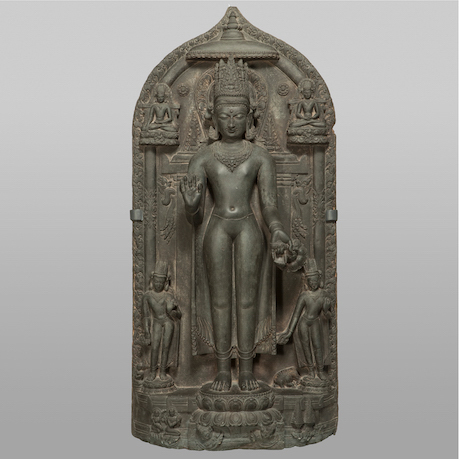
Standing Crowned Buddha with Four Scenes of His Life; Southern Magadha region, Bihar, India; ca. 1050″“1100; Basalt; Asian Art Museum of San Francisco; The Avery Brundage Collection, B65S11
The historical Buddha stands before us, fully enlightened, yet he wears the jewels and crown of his earlier princely life. The figure’s seeming androgyny similarly signals that this is an image of the awakened state, unbounded by dualities. It is, at once, the Buddha and all buddhas.
As you stand before this figure, recall that your mind has the capacity to encompass object and subject simultaneously. The image is both the object of our contemplation and, if seen from the right perspective, a likeness of its beholder’s buddha-nature. Look for your reflection in it, and it in you.

Aparna Nancherla started out doing comedy in her hometown of Washington, DC, and now resides in New York City. Elle‘s 2016 Women in Comedy Issue featured her as one of the most exciting new voices to hit the comedy scene. She is a series regular in Corporate and has roles in Crashing and The Standups. Her other television credits include Mythic Quest: Raven’s Banquet,Master of None, Love, High Maintenance, Inside Amy Schumer, Unspun with Matt Forde, and I Love You, America with Sarah Silverman. She is the voice of Meena on Mira, Royal Detective, Hollyhock on BoJack Horseman, and Moon on The Great North. Her TV writing credits include Late Night with Seth Meyers, and she is a regular correspondent and writer on Totally Biased with W. Kamau Bell.
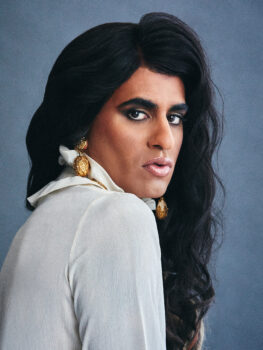
Alok Vaid-Menon (they/them) is an internationally acclaimed gender non-conforming writer, performer, and public speaker. As a mixed-media artist, Alok explores themes of trauma, belonging, and the human condition. Over the past decade they have presented at more than 500 venues in over 45 countries. They are the author of Femme in Public (2017) and Beyond the Gender Binary (2020), as well as the creator of #DeGenderFashion, a movement to degender fashion and beauty industries. Alok has been honored as one of HuffPost’s Culture Shifters, NBC’s Pride50, and Business Insider’s The Doers. They currently serve as a contributing editor to the White Review.
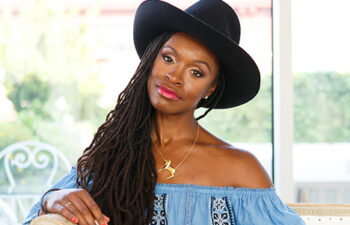
Latham Thomas is the founder of Mama Glow, a global maternal health and education brand serving birthing people along the childbearing continuum, and a doula education platform empowering birth workers around the world. Named one of Oprah Winfrey’s SuperSoul 100, Latham is a fierce advocate for birth equity and works to bridge policy gaps in maternal health. She is a co-founder of The Continuum Conference, a gathering centering the experience of fertility, pregnancy, and new motherhood, and the Mama Glow Foundation, which advances reproductive justice through education, advocacy, and the arts. Latham has served as a doula and lifestyle guru for celebrity clients including Alicia Keys, Anne Hathaway, Gabrielle Union, and more. She is a graduate of Columbia University and author of two best-selling books: Own Your Glow: A Soulful Guide to Luminous Living and Crowning the Queen Within and Mama Glow: A Hip Guide to Your Fabulous Abundant Pregnancy. She is the proud mother of 17-year-old DJ prodigy, producer, and entrepreneur DJ Fulano.
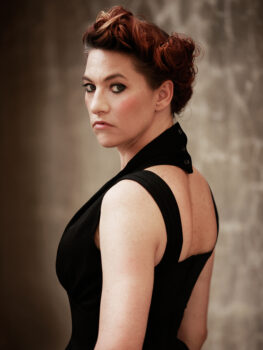
Amanda Palmer is a singer, songwriter, playwright, pianist, author, director, and blogger who simultaneously embraces and explodes traditional frameworks of music, theater, and art. She first came to prominence as part of the punk cabaret duo The Dresden Dolls, earning global applause for their inventive songcraft and wide-ranging theatricality. Her solo career has proven equally brave and boundless, featuring such groundbreaking works as the fan-funded Theatre Is Evil, which made a top 10 debut on the Billboard 200 in 2012 and remains the top-funded original music project on Kickstarter. Her 2013 TED talk “The Art of Asking” has been viewed over 20 million times worldwide. Palmer expanded her philosophy into the New York Times best-selling memoir The Art of Asking: How I Learned to Stop Worrying and Let People Help.
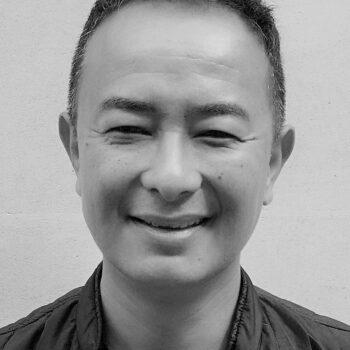
Tsherin Sherpa was born in Kathmandu, Nepal, in 1968, and currently lives and works between California and Nepal. From the age of 13, he was trained in traditional Tibetan thangka painting by his father, Master Urgen Dorje. In 1998, Sherpa immigrated to California, where he taught traditional thangka painting until he began to explore his own style, drawing on the visual vocabulary of thangka painting to create artworks that incorporate Buddhist iconography and pop-culture references. His works offer an interplay and juxtaposition between sacred/secular, traditional/contemporary, and settlement/movement. Sherpa’s practice stems from his personal experiences within the Himalayan diaspora, as well as the nomadic history of Himalayan peoples. Sherpa has participated in numerous exhibitions in Asia, Europe, and the US, including representing Nepal for its inaugural participation at the Venice Biennale in 2022. His works are in major museum collections. In February 2022, the Virginia Museum of Fine Arts presented his first museum, mid-career retrospective.
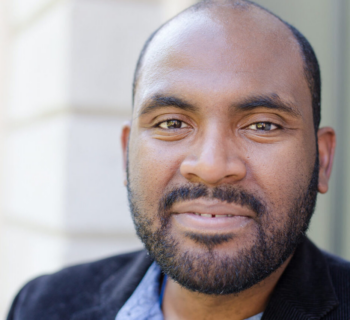
Lama Rod Owens is an author, activist, formally authorized Buddhist teacher, and graduate of Harvard Divinity School. He is the cofounder of Bhumisparsha, a Tantric Buddhist practice community as well as a co-author of Radical Dharma: Talking Race, Love, and Liberation. Love and Rage: The Path of Liberation through Anger was published in 2020.
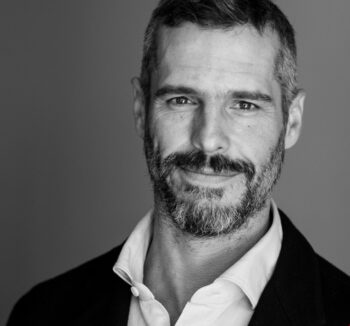
Dr. BJ Miller is a longtime hospice and palliative medicine physician. He currently sees patients and families via telehealth through Mettle Health, a company he cofounded with the aim to provide holistic care for individuals and families who need help navigating the practical, emotional, and existential issues that come with serious illness and disability.
Led by his own experiences as a patient, BJ advocates for the roles of our senses, community, and presence in designing a better ending. His interests are in working across disciplines to affect broad-based culture change, as well as furthering the message that suffering, illness, and dying are intrinsic aspects of life. BJ has given over 100 talks on the topics of death, dying, palliative care, and the intersection of healthcare with design.
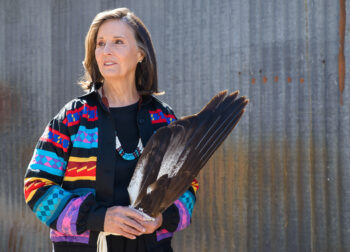
Patricia James is a Medicine Woman of Seminole heritage who was adopted and traditionally trained as a Cheyenne Pipe Carrier and Cheyenne Priest. She is a cross-cultural expert whose work is informed by the mentorship of Basque cross-cultural anthropologist, Angeles Arrien, Cheyenne Grandfather, Eugene Blackbear, Sr., and her work with the elders of multiple psycho-spiritual modalities.
She is a teacher, mentor, and consultant for the California Institute of Integral Studies (CIIS) certificate program in Psychedelic Therapy and Research (CPTR). She maintains a private practice in the San Francisco Bay Area that focuses on psycho-spiritual mentoring, integration, teaching, speaking, group and individual workshops. She also provides ritual-based ceremonies.
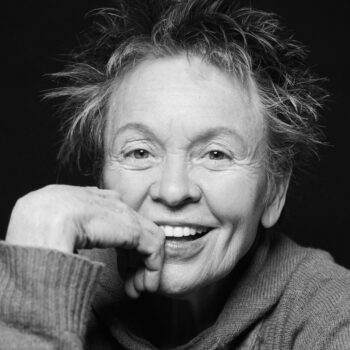
Laurie Anderson is one of America’s most renowned and daring creative pioneers. She is best known for her multimedia presentations and innovative use of technology. As writer, director, visual artist, and vocalist she has created groundbreaking works that span the worlds of art, theater, and experimental music. Ms. Anderson has published seven books, and her visual work has been presented in major museums around the world. In 2002 she was appointed the first artist-in-residence of NASA, which culminated in her 2004 touring solo performance The End of the Moon. Her film Heart of a Dog was chosen as an official selection of the 2015 Venice and Toronto Film Festivals and received a special screening at the Rubin Museum, where she joined in conversation with Darren Aronofsky. Ms. Anderson has made many appearances at the Rubin, and has been in conversation with Wim Wenders, Mark Morris, Janna Levin, Gavin Schmidt, Neil Gaiman, and Tiokasin Ghosthorse. She also hosted the premiere season of the Rubin’s AWAKEN podcast.
Get the latest news and stories from the Rubin, plus occasional information on how to support our work.